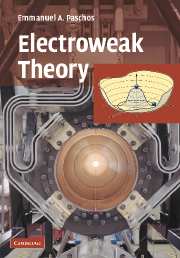Book contents
Epilogue
Published online by Cambridge University Press: 03 December 2009
Summary
In this book, the reader has had the opportunity to follow the development of the electroweak theory and the discovery of several new phenomena predicted by the theory. We have analyzed several of them in various chapters. The richness of the field and its high level of accuracy have been achieved with the help of several very large, very accurate, and refined experiments.
The potential for discovery has not yet been exhausted because the theory must be completed with the discovery of the Higgs particle(s) or some other symmetrybreaking scheme. Experiments at the LHC will either discover the Higgs boson or find new interactions indicating another mechanism for the breaking of symmetry. There is another observation in addition to symmetry-breaking that demands extension of the theory: the mixing and mass differences of neutrinos. Most of our colleagues speculate about a larger theory. Grand unified theories will unify the electroweak with the strong interactions, at some high energy bringing the three coupling constants together. The main issue here is to find predictions unique to the grand unified theory that will be verified by experiment. The symmetry of the new theory and the particle classification within the group remain open issues.
An alternative theory is supersymmetry, with many more particles. Supersymmetry is a symmetry relating fermions to bosons and must be broken. There are many different symmetry-breaking schemes. Predictions of the minimal supersymmetric theory will be tested at the LHC.
A parallel development has been the association of weak and electromagnetic interactions with astronomical and cosmological phenomena.
Information
- Type
- Chapter
- Information
- Electroweak Theory , pp. 234 - 235Publisher: Cambridge University PressPrint publication year: 2007
